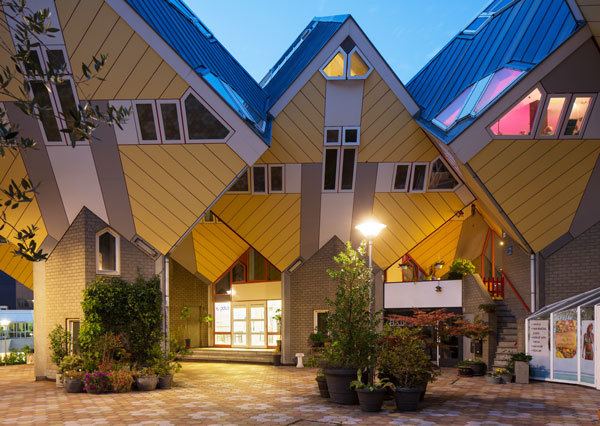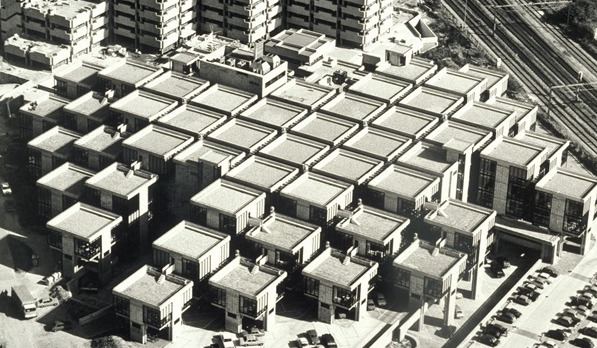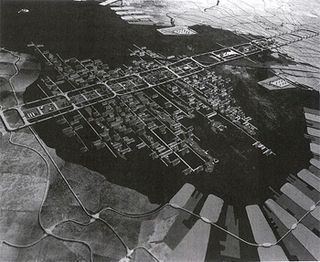 | ||
Lecture by Herman Hertzberger
Structuralism is a movement in architecture and urban planning evolved around the middle of the 20th century. It was a reaction to CIAM-Functionalism (Rationalism) which had led to a lifeless expression of urban planning that ignored the identity of the inhabitants and urban forms.
Contents
- Lecture by Herman Hertzberger
- Structuralism as parallel movement to Postmodernism
- Various movements and directions
- Origins
- Manifesto
- Otterlo Congress participants
- Definition of the structuralist form
- Theoretical origins principles and aspects
- Housing estates buildings and projects
- Aesthetics of number
- Structure and coincidence two components approach participation
- Historic cities
- Historic cities reciprocity of form
- New cities
- Interrelationships between social and built structures Team 10
- Literature Interpretations since 1969
- References

Structuralism in a general sense is a mode of thought of the 20th century, which came about in different places, at different times and in different fields. It can also be found in linguistics, anthropology, philosophy and art. At the beginning of the general article Structuralism the following explanations are noted:

"Structuralism is a theoretical paradigm emphasizing that elements of culture must be understood in terms of their relationship to a larger, overarching system or structure."

Alternately, as summarized by philosopher Simon Blackburn, "Structuralism is the belief that phenomena of human life are not intelligible except through their interrelations. These relations constitute a structure, and behind local variations in the surface phenomena there are constant laws of abstract culture."

Structuralism as parallel movement to Postmodernism
In Europe, structuralism is seen as a parallel movement to American postmodern architecture. The first interpretations of both movements came up in the 1960s. Through publications and presentations by authors such as Charles Jencks, Robert Venturi and Denise Scott Brown, postmodern architecture was successful throughout the world for decades. While postmodernism is concerned with an architectural style, many aspects of architecture and urbanism are treated in the structuralist movement.
In contrast to the postmodern movement, structuralism has developed more slowly, less noticeably during several periods in the last decades. The theoretical contributions of structuralism were developed in Europe, Japan, US and Canada. In 2011, the first comprehensive compilation of structuralist activity appeared in a publication called, "Structuralism Reloaded". In this extensive book, articles by 47 international authors were published about philosophical, historical, artistic and other relevant aspects. The selecting process for all these different views, including what is more or less important, needs time to give a definitive overall picture of structuralism. The following parts of this article are based on the current state of the publication, "Structuralism Reloaded".
A few months after publishing this book, the RIBA Institute in London discussed the new candidates for the RIBA Gold Medal in 2012. An actual question was: "Should the Venturis be given this year's RIBA Gold Medal?" Surprisingly enough, the RIBA-committee did not award the Venturis with their postmodernist view, and instead, gave Herman Hertzberger the prize for his structuralist architecture and theoretical contributions. The times had changed and a shift in emphasis had occurred. The comment of the former RIBA president Jack Pringle was: "The Royal Gold Medal, Britain's most prestigious award, should go to an architect that has taken us forward, not backwards." Today, postmodern architecture can be compared, to some degree with the architectural movement, Traditionalismus, in Europe.
Various movements and directions
The anthropologist, Claude Lévi-Strauss, remarked: "I do not believe that we can still speak of one structuralism. There were a lot of movements that claimed to be structuralist." This diversity can also be found in architecture. However, architectural structuralism has an autonomy that does not comply with all the principles of structuralism in human sciences. In architecture, the different directions have created different Images. In this article two directions are discussed. Sometimes these occur in combination.
On the one hand, there is the Aesthetics of Number which was formulated by Aldo van Eyck in 1959. This concept can be compared to cellular tissue. The most influential prototype of this direction is the orphanage in Amsterdam by Aldo van Eyck, completed in 1960. The Aesthetics of Number can also be described as Spatial Configurations in Architecture or Mat-Building (Alison Smithson).
On the other hand, there is the Architecture of Lively Variety (Structure and Coincidence) which was formulated for user participation in housing by John Habraken in 1961. Also, in the 1960s, many well-known utopian projects were based on the principle of Structure and Coincidence. The most influential prototype of this direction is the Yamanashi Culture Chamber in Kofu by Kenzo Tange, completed in 1967. Similar notions of Architecture of Lively Variety are: Architecture of Diversity, Pluralistic Architecture, Two-Components-Approach or Open Structures.
Origins
Structuralism in architecture and urban planning had its origins in the Congrès International d'Architecture Moderne (CIAM) after World War II. Between 1928 and 1959, the CIAM was an important platform for the discussion of architecture and urbanism. Various groups with often conflicting views were active in this organization; for example, members with a scientific approach to architecture without aesthetic premises (Rationalists), members who regarded architecture as an art form (Le Corbusier), members who were proponents of high- or low-rise building (Ernst May), members supporting a course of reform after World War II (Team 10), members of the old guard and so on. Individual members of the small splinter group Team 10 laid the foundations for Structuralism. The influence of this team was later interpreted by second generation protagonist Herman Hertzberger when he said: "I am a product of Team 10." As a group of avant-garde architects, Team 10 was active from 1953 to 1981, and two different movements emerged from it: the New Brutalism of the English members (Alison and Peter Smithson) and the Structuralism of the Dutch members (Aldo van Eyck and Jacob Bakema).
Outside Team 10, other ideas developed that furthered the Structuralist movement - influenced by the concepts of Louis Kahn in the United States, Kenzo Tange in Japan and John Habraken in the Netherlands (with his theory of user participation in housing). Herman Hertzberger and Lucien Kroll made important architectural contributions in the field of participation.
In 1960, the Japanese architect Kenzo Tange designed his well-known Tokyo Bay Plan. Reflecting later on the initial phase of that project, he said: "It was, I believe, around 1959 or at the beginning of the sixties that I began to think about what I was later to call Structuralism." Tange also wrote the article "Function, Structure and Symbol, 1966", in which he describes the transition from a functional to a structural approach in thinking. Tange considers the period from 1920 to 1960 under the heading of "Functionalism" and the time from 1960 onwards under the heading of "Structuralism".
Le Corbusier created several early projects and built prototypes in a Structuralist mode, some of them dating back to the 1920s. Although he was criticized by the members of Team 10 in the 1950s for certain aspects of his work (urban concept without a "sense of place" and the dark interior streets of the Unité), they nevertheless acknowledged him as a great model and creative personality in architecture and art.
Manifesto
One of the most influential manifestos for the Structuralist movement was compiled by Aldo van Eyck in the architectural magazine Forum 7/1959. It was drawn up as the programme for the International Congress of Architects in Otterlo in 1959. The central aspect of this issue of Forum was a frontal attack on the Dutch representatives of CIAM-Rationalism who were responsible for the reconstruction work after World War II, (for tactical reasons, planners like van Tijen, van Eesteren, Merkelbach and others were not mentioned). The magazine contains many examples of and statements in favour of a more human form of urban planning. This congress in 1959 marks the official start of Structuralism, although earlier projects and buildings did exist. Only since 1969 has the term "Structuralism" been used in publications in relation to architecture.
Otterlo Congress – participants
Some presentations and discussions that took place during the Otterlo Congress in 1959 are seen as the beginning of Structuralism in architecture and urbanism. These presentations had an international influence. In the book CIAM '59 in Otterlo the names of the 43 participating architects are listed. While the term structuralism in architecture was published for the first time in 1969.
L. Miquel, Alger / Aldo van Eyck, Amsterdam / José A. Coderch, Barcelona / Wendell Lovett, Bellevue-Washington / Werner Rausch, Berlin / W. van der Meeren, Bruxelles / Ch. Polonyi, Budapest / M. Siegler, Genf / P. Waltenspuhl, Genf / Hubert Hoffmann, Graz / Chr. Fahrenholz, Hamburg / Alison Smithson, London / Peter Smithson, London / Giancarlo De Carlo, Milan / Ignazio Gardella, Milan / Vico Magistretti, Milan / Ernesto Nathan Rogers, Milan / Blanche Lemco van Ginkel, Montreal / Sandy van Ginkel, Montreal / Callebout, Nieuport / Geir Grung, Oslo / Arne Korsmo, Oslo / Georges Candilis, Paris / Alexis Josic, Paris / André Wogenscky, Paris / Shadrach Woods, Paris / Louis Kahn, Philadelphia / Viana de Lima, Porto / F. Tavora, Porto / Jacob B. Bakema, Rotterdam / Herman Haan, Rotterdam / J.M. Stokla, Rotterdam / John Voelcker, Staplehurst / Ralph Erskine, Stockholm / Kenzo Tange, Tokyo / Terje Moe (architect), Trondheim / Oskar Hansen, Warszawa / Zofia Hansen, Warszawa / Jerzy Soltan, Warszawa / Fred Freyler, Wien / Eduard F. Sekler, Wien / Radovan Niksic, Zagreb / Alfred Roth, Zurich
Definition of the structuralist form
Since structuralism has different directions, there is more than one definition. The theoretical contribution by Herman Hertzberger belongs to the most interesting versions. A recent and often cited statement by Hertzberger is: "In Structuralism, one differentiates between a structure with a long life cycle and infills with shorter life cycles."
A more detailed description by Hertzberger is published in 1973. It is a structuralist definition in a general sense, but also the basis concept for user participation: "The fact that we put 'form' in a central position with respect to such notions as 'space' or 'architecture', means in itself no more than a shifting of accent. What we are talking about is in fact another notion of form than that, which premises a formal and unchanging relationship between object and viewer, and maintains this. It is not an outward form wrapped around the object that matters to us, but form in the sense of inbuilt capacity and potential vehicle of significance. Form can be filled-in with significance, but can also be deprived of it again, depending on the use that's made of it, through the values we attach to, or add to it, or which we even deprive it of, - all this dependent on the way in which the users and the form react to, and play on each other. The case we want to put is, that it is this capacity to absorb, carry and convey significance that defines what form can bring about in the users - and conversely - what the users can bring about in the form. What matters is the interaction of form and users, what they convey to each other and bring about in each other, and how they mutually take possession of each other. What we have to aim for, is, to form the material (of the things we make) in such a way that - as well as answering to the function in the narrower sense - it will be suitable for more purposes. And thus, it will be able to play as many roles as possible in the service of the various, individual users, - so that everyone will then be able to react to it for himself, interpreting it in his own way, annexing it to his familiar environment, to which it will then make a contribution." p. 56
Compared to other directions of structuralism in architecture, the following clarifications are noted: "In the new architectural movement there is often a tendency to call everything Structuralist that resembles a woven texture and has a grid. This would be a superficial way of looking at things. By nature Structuralism is concerned with the configuration of conditioned and polyvalent units of form (spatial, communicational, constructional or other units) at all urban scales. Only when the users have taken possession of the structures through contact, interpretation or filling-in the details, do the structures achieve their full status. Any architecture that has a tendency to formalism is thus excluded. Flexible form, which has been much discussed, is also rejected as a neutral enclosing system, since it does not offer the appropriate solution for any spatial programme. In the architecture of Herman Hertzberger Structuralist form can be found from the smallest detail up to the most complicated structure, whether it is in terms of spatial, facade or environmental design." p. 56
The next quotation is a definition of structuralism in different fields. It also discusses the autonomy of the primary structure: "Many Structuralists would describe a structure roughly in the following terms: it is a complete set of relationships, in which the elements can change, but in such a way that these remain dependent on the whole and retain their meaning. The whole is independent of its relationship to the elements. The relationships between the elements are more important than the elements themselves. The elements are interchangeable, but not the relationships." p. 16
Theoretical origins, principles and aspects
The principle Structure and Coincidence remains relevant until now, both for housing schemes and urban planning. For housing schemes the following images were influential: the perspective drawing of the project "Fort l'Empereur" in Algiers by Le Corbusier (1934) and the isometric drawing of the housing scheme "Diagoon" in Delft by Herman Hertzberger (1971). At city level, important projects were: the Tokyo Bay Plan of Kenzo Tange (1960) and the fascinating images of the model of the Free University of Berlin by Candilis Josic & Woods (1963). Also, worth mentioning are the utopias of Metabolism, Archigram and Yona Friedman. In general, instruments for urban structuring are: traffic lines (e.g. gridiron plans), symmetries, squares, remarkable buildings, rivers, seashore, green areas, hills etc. These methods were also used in previous cities.
The principle Aesthetics of Number proved to be less useful for structuring an entire city. However, exemplary articulated configurations did arise, both in architecture and housing schemes. The first influential images for this direction Aldo van Eyck provided with aerial photos of his orphanage in Amsterdam (1960). Later he built another inspiring configuration for the Space Centre Estec in Noordwijk (1989). These two compositions can be counted among the most beautiful "icons" of structuralism.
Housing estates, buildings and projects
Aesthetics of number
The term "aesthetics of number" is introduced by Aldo van Eyck in the architectural magazine Forum 7/1959. In his article van Eyck showed two works of art: a structuralist painting by the contemporary artist Richard Paul Lohse and a Kuba textile (Bakuba tissue) by an African artist of the "primitive" culture. The combination of these two cultures has a symbolic meaning in the structuralist movement.
Structure and coincidence – two-components approach – participation
In the 1960s the structuralists criticised the narrowness of the functional principle "Form Follows Function". In historic cities they found solutions for a new form principle: an interpretable, adaptable and expandable architecture, see below "Historic cities - reciprocity of form". In the magazine Forum they developed ideas about "polyvalent form and individual interpretations", "reciprocity of form" and "participation". In our time the notion "open structures" is also used in discussions.
Historic cities
Examples of urban planning and urban structuring. About the relation between historic and contemporary architecture Le Corbusier wrote: "I was labelled a revolutionary, whereas my greatest teacher was the Past. My so-called revolutionary ideas are straight out of the history of architecture itself." Quotation in No.2.
Historic cities – reciprocity of form
In Forum 2/1962 Jacob Bakema made a study on the principle "reciprocity of form" and "participation", especially on the Diocletian's Palace in Split. In Forum 3/1962 Herman Hertzberger did research on the Roman amphitheatres in Arles and Lucca. Later, in 1966 the idea of the amphitheatre in Arles was taken over by Aldo Rossi in his book The Architecture of the City. In 1976 Reyner Banham presented the Ponte Vecchio in Florence as one of the historic prototypes in his book Megastructure.
New cities
New cities in the twentieth century. The term "Urban Structuring" is introduced by Alison and Peter Smithson, the term "Articulations" (of the built volume) by Herman Hertzberger. Both terms are used as a title of an architectural book.
Interrelationships between social and built structures (Team 10)
De Drie Hoven residential building for elderly people in Amsterdam-Slotervaart by Herman Hertzberger, 1974. In the original state, the primary megastructure was light grey (prefabricated concrete) and the facade elements dark grey and matt (wood construction). Today, the original proportions and colors of the facade elements are changed by the intervention of an unknown architect. Herewith the fine architectural quality of the original building complex has disappeared.
Kasbah housing estate in Hengelo by Piet Blom, 1973
